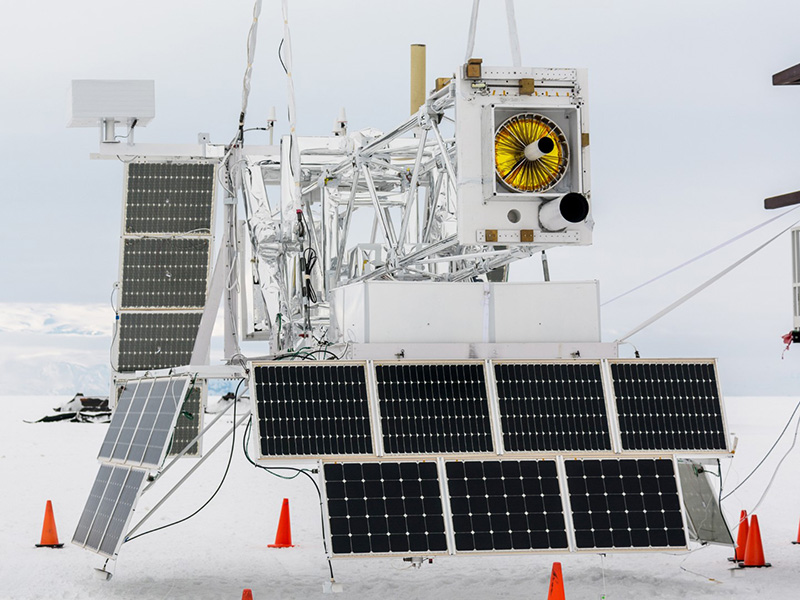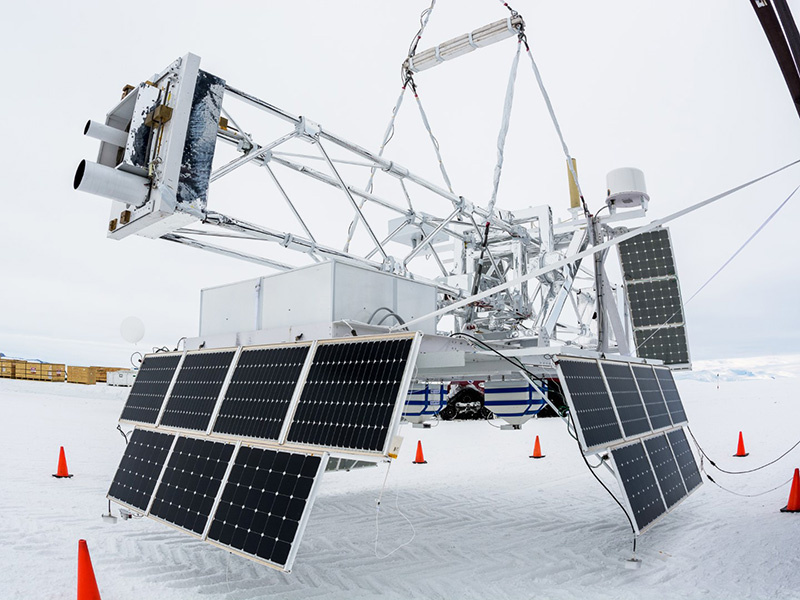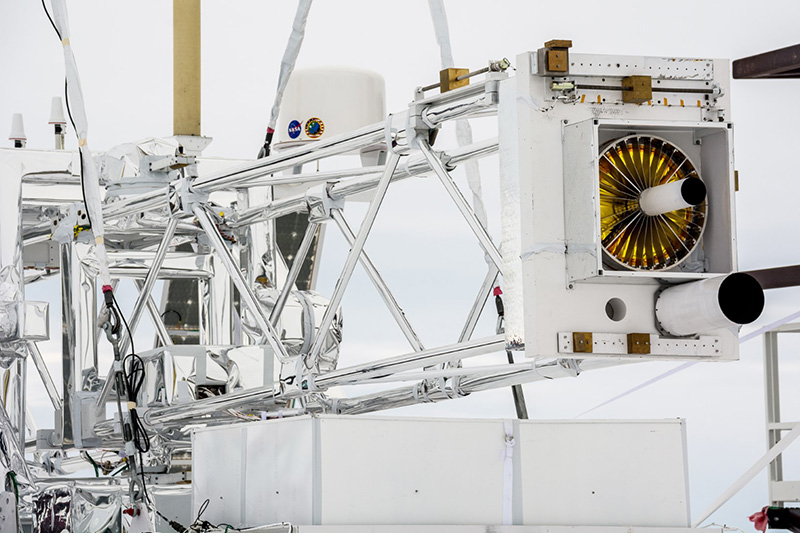
Photo Credit: Mike Lucibella |
The X-Calibur telescope undergoes a "hang test" in preparation for its launch. |
The Flight of X-Calibur
Testing Neutron Stars' Mettle
By Michael Lucibella, Antarctic Sun Editor
Posted July 23, 2019
Antarctica can be a double-edged sword for astronomers: conditions there are some of the best in the world for observing the heavens, but the harshness of the place can be hard on equipment.

Photo Credit: Mike Lucibella
The X-Calibur telescope was designed to study the x-rays emitted by neutron stars and black holes.
In December 2018, astronomers who launched the x-ray telescope "X-Calibur" to study neutron stars and black holes got a taste of that contrast.
Unfortunately, while technical difficulties prevented the telescope from staying aloft as long as hoped, the researchers were able to gather useable data from their target.
The gleaming telescope was carried into the upper edge of the atmosphere on a helium balloon the size of a football field. The telescope worked perfectly, and researchers collected tantalizing astronomical data on some of the galaxy's most exotic celestial objects.
Neutron Stars are the dense remains of stars which, at the end of their "life," were not quite large enough to collapse into black holes. Gravity crushes the dying star, fusing electrons and protons together in the process and forming small stars made entirely of neutrons. It is the densest matter in the universe; a single teaspoon is estimated to weigh as much as 10 million tons.
The NASA-funded project was launched by the Columbia Scientific Balloon Facility at McMurdo Station. The National Science Foundation, which manages the U.S. Antarctic Program, is supporting the Antarctic field operations of the project.
Behold X-Calibur
"It's a telescope that we use to study things such as black holes [and neutron stars]," said Fabian Kislat, an astronomer at the University of New Hampshire. "It measures x-rays but unlike a normal x-ray telescope, it doesn't make an image. It takes a spectrum of the light, but instead it measures its polarization."

Photo Credit: Mike Lucibella
Even while suspended from a balloon at 130,000 feet, the telescope can point at its target with pinpoint accuracy.
Light travels in waves, and the polarization of light is essentially how much those light waves line up with each other, and in what direction they're aligned. This is true across all wavelengths of light, including the high-energy x-rays that X-Calibur is tuned to.
"For the very first time we're observing not only the arrival time and energy of the x-rays, but also the polarization," said Henric Krawczynski, a physicist at Washington University in St. Louis and principal investigator on the project. "The polarization depends on how the x-rays scatter and that'll tell you something about the geometry close to the black hole or close to the neutron stars."
For this flight, the team focused on studying x-rays emitted by neutron stars, but their work can also offer insights into emissions from the super-hot regions surrounding black holes.
"These are the brightest objects in our galaxy in the x-ray band," Krawczynski said. "They have been studied a lot in spectral and timing observations, but never in this polarization."
Because of their incredible density, neutron stars are also small, only a few kilometers in diameter, and they're many light years away, so it's impossible for even the most powerful telescopes to create an image of their structure. Astronomers have developed simulations of them to try to understand their behavior and are hoping that data taken from X-Calibur can be used to test some of their theories about their magnetic-field structure.
X-Calibur Illuminates
Neutron stars, as well as black holes, generate powerful magnetic fields that collect, or "accrete," matter around their poles which become super-heated, ionize and emit brilliant jets of energy and radiation, including high-energy x-rays.

Photo Credit: Mike Lucibella
A series of concentric mirrors at the end of the telescope's 8-meter boom focus the incoming x-rays onto X-Calibur's detector.
"Due to the strong nature of the magnetic field of the neutron star, you get these accretion columns towards the poles where the matter just sort of falls towards the poles and that gives rise to the x-ray emissions," Kislat said.
However, the precise mechanics of what's happening is unclear. Astronomers aren't sure whether the x-rays originate right at the surface of the star itself, or whether the matter in the accretion column, suspended in the magnetic field some distance away from the star's surface, is dense enough that it emits its own x-rays.
They hope to be able to tell from the polarization of the x-rays which scenario is correct. If the x-rays originate at the surface, their polarizations would line up in a column along the paths of their bright polar jets, what scientists call the "pencil beam" model. As the star rotates, its column of x-rays would sweep across the Earth and the polarization would appear greatest when it's at its brightest.
Conversely, if the ionized matter suspended in the magnetic field is what is generating the high-energy x-rays, they will appear most polarized when the bright polar jets are pointed away from Earth. Scientists call this the "fan beam" model as the matter emits x-rays from the sides of the jets in all directions.
"What we're looking for is whether the x-rays are more strongly polarized when it's bright or when it's dim. These two scenarios, 'pencil beam' versus 'fan beam' lead to exact opposite polarization signatures," Kislat said. "There is a clear signature in polarization that distinguishes that two extreme scenarios, it could be somewhere between those as well."
There's a similar process that happens in black holes, but the team focused their attention on neutron stars as they're what are most visible from the southern hemisphere.
"If you just look at the five brightest sources in the southern sky that we can see from Antarctica, x-ray sources, you'll find that they're all accreting neutron stars," Kislat said. "Those are the ones that are on average bright enough that we can look at them during this flight and get sufficient data to make a meaningful measurement."
How these x-ray jets form might seem like a subtle point; however, it ties in with broader questions about the how matter behaves in extreme environments and under extreme circumstances.
"In the end it's about studying fundamental physical questions," Kislat said. "Black holes really have a profound influence on their surroundings, in particular if we look at supermassive black holes at the centers of galaxies. They hold the galaxy together. Outflows from supermassive black holes influence the formation of stars. It all kind of ties together in this big theme of better understanding the universe's evolution, understanding what's out there in our galaxy."
Forging X-Calibur
The team launched the X-Calibur telescope on December 29, carried aloft on one of NASA's super pressure long-duration helium balloons. The balloon swelled as it floated up to about 125,000 feet, above roughly 99 percent of the Earth's atmosphere, and started collecting data.

Photo Credit: Mike Lucibella
The 150-foot helium balloon lifts X-Calibur, ultimately carrying it up to an altitude of 130,000 feet.
Astronomers trained their floating, 8-meter long telescope on GX 301-2, a neutron star with a powerful magnetic field that's ripping apart its tightly-orbiting companion star.
After traveling nearly 10,000 light years through space, the neutron star's photons passed through the telescope's x-ray mirror to focus it onto the detector. Though the mirror focuses the x-rays, it's not a lens in the traditional sense. Because of their small wavelengths, x-rays can only be bent a few degrees. Installed at the end of an 8-meter long truss, the x-ray mirror is made up of 255 concentric mirrors nestled within each other to reflect, rather than refract, the incoming x-rays onto the focus target. That target is a slender beryllium crystal that scatters the light into one of 17 surrounding detectors that records the polarization of the incoming x-rays.
Building the carbon fiber truss to mount the telescope's x-ray mirror was no small task. The beryllium element is only the size of a human finger, so the 8-meter long boom holding the mirror was built to be extremely rigid, so it doesn’t flex and cause the x-rays to miss their target.
"That was a pretty big undertaking," said Dana Braun, a mechanical technician at Washington University in St. Louis who helped build the telescope. "Everything has to be as light as you can make it. It's a big instrument."
Unfortunately, the flight was cut short because of balloon troubles. After being aloft for only four days it started losing pressure and the telescope landed on the Polar Plateau in East Antarctica.
Though incomplete, it appears initially that evidence is pointing towards the fan-beam model, but the results are not yet conclusive, and more data are needed.
However, the team is not ready to sheath their swords just yet and are already designing the next generation of telescope. Dubbed "XL-Calibur," it'll be 12 meters long and equipped with a larger mirror to collect more data about neutron stars and black holes. They're hoping to launch their first test flight in 2021.









